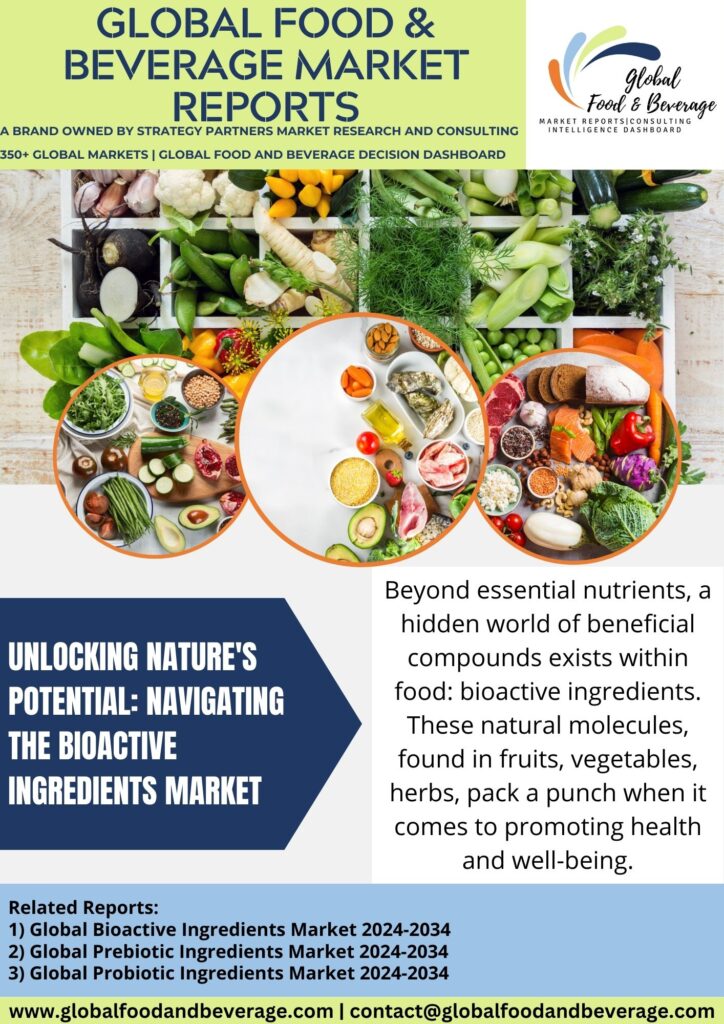Bioactive ingredients are compounds found in food and natural substances that have specific physiological effects on the human body, promoting health and well-being beyond basic nutrition. These ingredients, often derived from plants, herbs, and other natural sources, have gained increasing attention for their potential to positively impact various aspects of human health.

One notable category of bioactive ingredients is phytochemicals, which encompass a diverse group of compounds with antioxidant, anti-inflammatory, and other health-promoting properties. Examples include flavonoids in fruits and vegetables, polyphenols in tea and red wine, and carotenoids in colorful vegetables. These compounds are believed to contribute to the prevention of chronic diseases, including cardiovascular diseases and certain cancers, by neutralizing free radicals and reducing oxidative stress in the body.
Another group of bioactive ingredients includes functional fibers, such as beta-glucans in oats and soluble fiber in fruits. These fibers have been associated with various health benefits, including improved digestive health, regulation of blood sugar levels, and the reduction of cholesterol. They play a crucial role in supporting gut microbiota, fostering a healthy balance of beneficial bacteria in the digestive system.
Omega-3 fatty acids, found in fatty fish like salmon and flaxseeds, represent another essential category of bioactive ingredients. These fatty acids, particularly eicosapentaenoic acid (EPA) and docosahexaenoic acid (DHA), contribute to cardiovascular health, brain function, and inflammation modulation. They are often recommended as part of a balanced diet to support overall well-being.
The emerging field of nutrigenomics explores the interaction between bioactive ingredients and an individual’s genetic makeup. Certain bioactive compounds have been shown to influence gene expression and metabolic pathways, allowing for personalized nutrition strategies tailored to an individual’s unique genetic profile. This personalized approach holds promise for optimizing health outcomes and preventing or managing specific health conditions.
The popularity of bioactive ingredients has led to their incorporation into functional foods, dietary supplements, and nutraceuticals. These products are designed to deliver concentrated doses of bioactive compounds, providing a convenient way for consumers to enhance their diets and address specific health concerns.
ADVANCEMENTS
Bioactive ingredients have transformed the landscape of functional foods, nutraceuticals, and skincare products, as consumers increasingly prioritize health and wellness. One significant breakthrough lies in the identification and isolation of novel bioactive compounds from various natural sources. Researchers are exploring diverse plant extracts, marine organisms, and microorganisms to discover bioactive ingredients with potential health benefits.
Advancements in extraction and purification technologies have improved the efficiency of isolating bioactive compounds from raw materials. Techniques such as supercritical fluid extraction, ultrasound-assisted extraction, and advanced chromatography methods allow for the targeted extraction of specific bioactive molecules, ensuring their purity and efficacy in end products.
The development of bioactive peptides is a notable trend within the realm of functional foods and nutraceuticals. These peptides, derived from proteins through enzymatic hydrolysis, exhibit various physiological activities, including antioxidant, anti-inflammatory, and antimicrobial properties. Bioinformatics and computational tools contribute to the design of peptides with enhanced bioavailability and targeted functionalities.
In skincare and cosmetic formulations, bioactive ingredients have advanced to address specific skin concerns. From plant-derived antioxidants like polyphenols and flavonoids to peptides that support collagen production, bioactive ingredients play a crucial role in formulating products that promote skin health and anti-aging effects.
Advancements in encapsulation technologies contribute to the stability and controlled release of bioactive ingredients in various applications. Microencapsulation and nanotechnology protect sensitive bioactives from degradation, ensuring their efficacy in functional foods, supplements, and personal care products.
The integration of artificial intelligence and data analytics in bioactive research facilitates the identification of synergistic effects and personalized applications. This approach enables a more precise understanding of how bioactive ingredients interact with individual health profiles, paving the way for personalized nutrition and skincare solutions.
CHALLENGES
The production and integration of bioactive ingredients into various consumer products face challenges stemming from sourcing, formulation, regulatory compliance, consumer education, and market competition. One significant challenge is securing a sustainable and reliable supply chain for raw materials. Many bioactive ingredients are derived from plants or natural sources, and ensuring a consistent supply while addressing issues such as climate variability, crop diseases, and geopolitical factors poses a considerable challenge.
Formulating products with bioactive ingredients presents complexities. Achieving the desired concentration, stability, and bioavailability of these ingredients without compromising the sensory attributes of the final product can be challenging. Striking the right balance between functionality and maintaining the product’s taste, texture, and appearance is crucial for consumer acceptance.
Regulatory compliance adds another layer of challenge to the bioactive ingredients industry. Meeting diverse and evolving regulations related to health claims, labeling, and safety standards requires ongoing diligence. Navigating different regulatory frameworks across regions or countries further complicates the development and marketing of products containing bioactive ingredients.
Consumer education is vital for the successful adoption of products with bioactive ingredients. Communicating the health benefits, proper usage, and scientific basis behind these ingredients is crucial for building consumer trust and encouraging informed purchasing decisions.
Market competition is intense in the bioactive ingredients sector. New product launches and innovations continually enter the market, demanding constant innovation and differentiation to stand out. Successfully navigating the competitive landscape involves not only addressing current trends but also anticipating and adapting to emerging consumer needs.
CONCLUSION
Bioactive ingredients epitomize a health-conscious revolution, embodying the fusion of science and nutrition. From antioxidants to phytochemicals, these compounds offer multifaceted benefits that extend beyond mere sustenance. As consumer awareness grows, the demand for functional foods and supplements rich in bioactives surges. The industry’s response reflects a commitment to holistic well-being and preventive health. The future unfolds with personalized nutrition, innovative extractions, and a deeper understanding of the human microbiome. In navigating this dynamic landscape, bioactive ingredients emerge as essential contributors to a healthier, more resilient lifestyle, where every meal becomes an opportunity for nourishment and proactive self-care.
